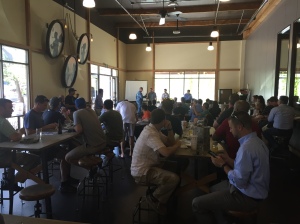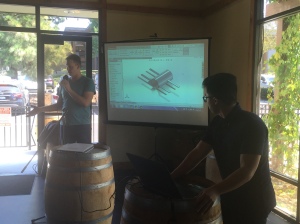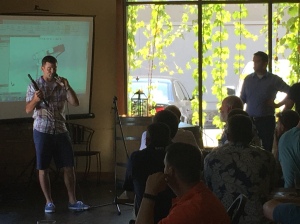By: The ATHENA Northwest Team
Earlier this summer we had the strongest showing and most excitement at an ATHENA Northwest event thus far. With a larger and more diverse audience, more presenters, and a new format for presentations, the latest Northwest Innovation competition set the bar high. Kicking off the event as a keynote speaker was Keith Archbold, the Chief Technology Officer for Naval Undersea Warfare Command, Keyport. Pulling from his experience with presidential cabinet level work in technology exploration and time as an entrepreneur in Silicon Valley, Keith captured the audience as he coined the innovation quotient. Describing how innovation is a result of demand (or capital to invest) over structural drag (those things that stifle entrepreneurialism), he promoted ATHENA as a key element in reducing the Military’s structural drag. Following Keith’s key note, the audience was divided up into groups, one for each presenter. Each presenter had the opportunity to pitch their idea several times as the groups rotated to hear each presenter. After several rounds, an initial vote was cast and the top three ideas advanced to a lightning round in front of the entire audience. A final round of voting produced the new Admiral Sim’s Winner for Intellectual Courage, ABF3 John Broussard. Here is a complete breakdown on the ideas presented.
*** The ATHENA Northwest 3.0 Admiral Sims Award for Intellectual Courage***
In-Port Recycling Program – ABF3 John Broussard, USS NIMITZ
John did his homework and it showed through his presentation. He won the audience over as he cited some staggering numbers showing the impact of ship generated trash to the size of landfills and how recycling is profitable. He unearthed several Navy instructions on shipboard recycling that lay out the duties and responsibilities of commands that host Navy ships pier side. Directly in alignment with the SECNAV’s and CNO’s push for greater sustainability, energy footprint reduction, and environmentally conscious decisions, this idea is a no brainer. Ships are even set-up for trash separation at sea, making it an easy idea to transition for the crew. Perhaps the most intriguing element of his pitch was what he intended to do with the profits from the recycling program. He would use the funds to purchase text-books for the common college classes taken onboard and establish a text-book loan program through the Ship’s library. We’ve connected John to the regional trash and recycling program manager as well as decision makers at NAS Kitsap to assist with implementing the in-port recycling program. Everyone involved is excited to see this happen!
Printer Ink and Toner Default Setting Change – AZAN Scott Bonk, NAS Whidbey Island
AZAN Bonk has a one-step solution to save the Navy millions of dollars. Every year the Navy uses hundreds of thousands of dollars in printer toner. What if there was a simple way to reduce this usage, without buying more equipment? Simply by reducing toner density and enabling economy mode on all commercial black and white printers and copiers, the Navy could save almost $1,000 a year per printer. Over time, and if implemented fleet wide, this initiative could save millions of dollars in operational costs.
AZAN Bonk conducted an experiment with two like HP Printer Models using the same ink cartridges to prove his case. He reduced the ink setting of one printer from the maximum of five down to three while leaving the other at the default setting of five. The results where astounding. The users of the reduced printer had no issues with their working documents while nearly doubling the page count for the ink cartridge as compared to the factory setting printer. The data AZAN Bonk extrapolated from this experiment shows that the Navy can indeed save and in a big way.
His idea is simple to enforce and costs to reset printer defaults is already embedded in the sunk costs of the Navy’s Information Technology manning and budget. This is a change that can be implemented fleet wide and the savings can have an immediate impact.
Smart Device Trivia Based App for Professional Knowledge Development – AO3 Brianna Frenette, USS JOHN C. STENNIS
These days there is a phone application for everything, but why is there no App for Navy education?
What if there was an application that would not only encourage Sailors to study but make it a fun friendly competition? AO3 Brianna Frenette wants to create a jeopardy game that asks different questions based on the category. For example, a sailor learning material for their Air Warfare would have categories to choose from relating to the different departments onboard the aircraft carrier.
Starting from a baseline of basic questions, the question data base will grow and evolve over time from user supplied questions. The answers will come from the subject matter experts in a virtual board who find and corroborate questions and answers. The answers will be derived from instructions, guides, procedures, books, bibliographies, and syllabi. If an incorrect question slips through the cracks they can easily be reported and reviewed.
Making it fun, Sailors can compete one-on-one or with other Sailors throughout the fleet. Making learning fun and challenging will better prepare Sailors for their jobs and qualifications. Brianna’s goal is to launch her Pro-Trivia App by establishing a company herself or joining with an app developer. Her long term goals are to expand knowledge apps across a full spectrum of educational disciplines and fields including military, commercial, private, grade school, and college level.
Hull climbing surveyor robot- Chris Stone, Puget Sound Naval Shipyard & Intermediate Maintenance Facility
Engineer Chris Stone thinks he has found the right “person” to do required survey work on ships that come into PSNS & IMF … a robot. Surveys are routinely performed when a vessel first enters dry dock at a shipyard and typically can put other work on hold until complete. At PSNS & IMF, these surveys are usually performed by two workers in a lift which necessitates the use of fall protection gear and requires additional hazard pay. The use of a remotely-controlled hull climbing robot, which already exists for other applications, to perform hull surveys would increase the speed and safety of the evolution. It would also increase consistency and reduce the chance of repetitive stress injuries. Only one worker would be required and by using multiple detectors, a larger swath could be covered faster than the current method, multiplying the time and cost savings. Since the tool/technology already exists for other applications, Chris and other engineers are in the process of testing it for this use.
Inspection Camera … on a Stick! – John Albrecht, Puget Sound Naval Shipyard & Intermediate Maintenance Facility
Mr. John Albrecht, PSNS & IMF civilian industrial engineer, presented an idea that uses a tool already available outside of the Navy: a portable, handheld, video endoscope for inspecting hard-to-reach spaces. The tool is one you might find car mechanics using to see inside engines without tearing anything apart, thanks to the flexibility of having a lighted probe on the end of a long cable. The benefit for Navy ship maintenance work is exponentially more, since it would allow for safer inspection of countless areas on both surface ships and submarines. It’s safer and faster because the inspector doesn’t need to move and climb ladders, or wear fall protection gear, or move specialized equipment. They just put their “camera on a stick” where they need to see, and use that system to identify which specific items need a more detailed, “up close and personal” inspection. Besides the safety factor, the tool would potentially save time and money in labor thanks to the advanced visual inspection capability.

Mandi McCrae and Allison Westergard provide practical ideas for incorporating healthier food options in the shipyard.
Healthy input/Healthy output – Mandi McCrae and Allison Westergard, Puget Sound Naval Shipyard & Intermediate Maintenance Facility
We know that what we fuel our bodies with is a direct correlation of how our body will perform. The tag team of Ms. Mandi McCrae and Allison Westergard decided that concept should be used to improve work performance too. As they said “we thought, what better way to increase our output than by influencing the input … to our bodies, that is.” Their idea to push for cleaner, healthier, and more wholesome food offered at the Shipyard was not to replace what is offered now, but to expand the options to include whole fruits, vegetables, and hearty grains. Instead of the sometimes chemically-laden, processed nutrition-LESS empty “foods”, the team proposed solutions that included allowing local companies to be allowed to provide more in the way of “delivering” to the shipyard and searching for additional food truck options that had healthier food. Here’s to truly increasing productivity!
Custom safety gear for teammate with underdeveloped hand – Ben Paddock, Puget Sound Naval Shipyard & Intermediate Maintenance Facility
One size does not always fit all, and when it comes to safety, a good fit is paramount. Ben Paddock, with PSNS & IMF’s Moonshine Lab, an innovation-fueled entity within the command, wants to make sure one of his teammates does get the right fit. A fellow PSNS & IMF worker has an underdeveloped hand, which makes some aspects of his job more difficult. While that teammate had been successful doing his job, donning required safety gear didn’t always offer him as much protection because of the poor fit on his hand. Gloves, in particular, were putting this worker in a situation to easily get his loose glove fingers stuck under heavy materials. At the time of Athena 3.0, Ben was still working on prototypes for a solution that would enable his teammate him to keep doing a great job, while keeping his hand protected.

ABF3 Jonte Johnson shows proposes a program to increase diversity of thought and build the professional networks of Sailors.
Distinguished Sailor Exploration Program – ABF3 Jonte Johnson, USS JOHN C. STENNIS
Jonte is a repeat offender when it comes to delivering powerful ideas to spur collaboration. While building on the concept he pitched at ATHENA Northwest 1.0 to improve collaboration between the ship, shipyard, and base for local improvements, he developed a second concept that looks a little like the traditional Distinguished Visitors Program turned inside out. He proposed a program to send several high performing Sailors to visit area industry, education, and government leaders once a quarter to learn their leadership, process development, management, and improvement strategies. The program intentionally focuses on building the personal network for these Sailors in order to empower them to make greater improvements and impacts both in the Navy and in the community. Jonte urged us all to never underestimate the power of networking and building people up through the positive relationships. Even if this idea finds no other home, we are considering how to apply this concept to the benefit of future ATHENA winners.
Torque Enabling Device for Wire Rope Connections – William Mooney, Puget Sound Naval Shipyard & Intermediate Maintenance Facility
Mr. William Mooney told the story of how the Shipyard has transitioned from wire cable to synthetic ropes when it comes to rigging and moving heavy objects. While the connection of synthetic rope was much simpler than the cumbersome joining of two wire cables, the results could be horrific in the event of a fire. Imagine the firefighters running in to put out the fire and the synthetic ropes melting, causing heavy loads to drop on those putting out the fire. Steel cable will never have that issue and Mr. Mooney designed a torque enabling device to simplify connecting wire rope and ensure a strong connection. He hopes to pursue a Navy patent on the tool and see a return to a safer material for shipyard rigging.

EM2 Deborah “Saga” Sagapolutele leaves no room for doubt concerning the shortfalls of the Physical Fitness Assessment (PFA) program and outlines some sensible alternatives. Little did she know, they were already in the works as revealed by the recent Naval Message outlining new PFA changes.
Passionate about how the current physical fitness regulations fail to set an equal playing field or promote strength, Saga led the audience through a couple of real life stories (her own being one of them) where someone failed the body composition assessment (BCA) but could measurably demonstrate superior fitness and strength. Coming from a Samoan heritage, she educated the audience on how the current BCA put certain body types at a disadvantage. Her goal is to adjust the PRT policy so that people who don’t make the Navy’s BCA standard could still take the PRT. She highlighted the fact that the Navy’s BCA standards were stricter than the DOD standard and that the DOD standard may be more reasonable for certain body types. If Sailors are under the DOD BCA and can pass the PRT with a “Good” or better, they should get a partial pass. The good news about this idea is that it is becoming a reality. Too good of an idea to ignore, it has surfaced in many places and from multiple sources, spurring a change to the policy. The next two PRT cycles will incorporate rules that make EM2 Saga’s idea a reality.
All in all, a fantastic event with another set of incredible ideas to better serve the mission of the Navy and Department of Defense. Looking forward to where these ideas will go!
Don’t forget!! ATHENA East 2.0 is happening in Norfolk on Friday, October 2nd at Work|Release at 1600. Register to be a voting member of the audience here: https://www.eventbrite.com/e/project-athena-east-naval-innovation-competition-tickets-18337452815
The ATHENA Northwest team is gearing up for their fourth installment, stay tuned for the announcement of ATHENA Northwest 4.0! Connect with The Athena Project on Facebook: www.facebook.com/athenanavy or follow us on Twitter: @AthenaNavy.
Interested in starting a movement of your own? Message us, or e-mail athenanavy@gmail.com!











